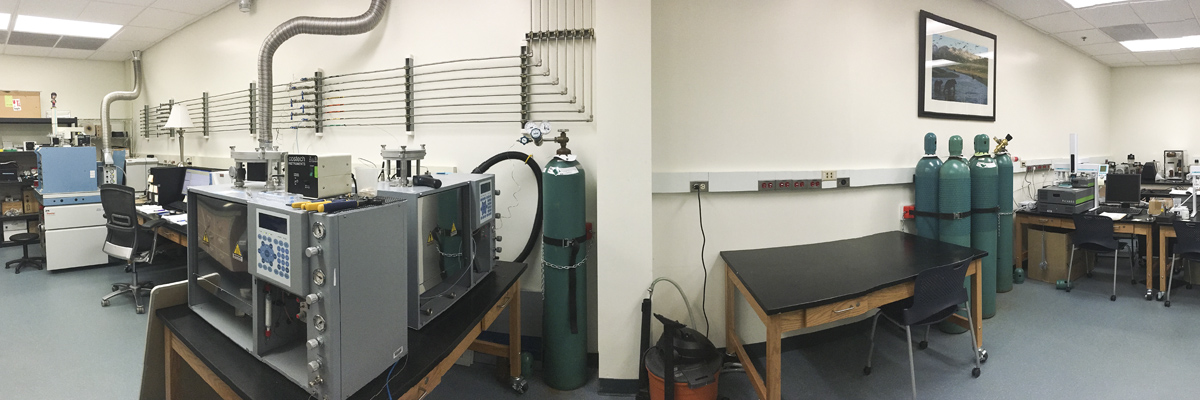Equipment and Capabilities
 ThermoFinnigan DeltaPLUS XP and Delta V Advantage – Continuous Flow Isotope Ratio
Mass Spectrometers (CF-IRMS)
ThermoFinnigan DeltaPLUS XP and Delta V Advantage – Continuous Flow Isotope Ratio
Mass Spectrometers (CF-IRMS)
The ThermoFinnigan isotope ratio mass spectrometers are fed by four analytical streams. An elemental combustion system for carbon and nitrogen and sulfur solids analysis (EA), and two temperature conversion elemental analyzers (TC/EA) for oxygen and hydrogen analysis (one for solids and one for liquids) are each connected to an isotope ratio mass spectrometer via a ThermoFinnigan ConFlo III interface
Picarro Wavelength Scanned Cavity Ring-Down Spectrometer (WS-CRDS)
The Picarro WS-CRDS system utilizes a CTC Analytics PAL autosampler to deliver a liquid water sample via injection into a vaporization chamber. The vaporized water sample is fed into a closed cavity for analysis, during which a discrete quantity of laser light is introduced into the cavity and the absorption curve of the light is used to determine the isotopic makeup of the water sample.
Costech Instruments – Elemental Combustion System (EA)
The EA is used for analysis of δC, δN, δ13C and δ15N in solid samples, including plants, soils, organisms, hair, and sediments. Samples are placed in tin cups and introduced to the elemental analyzer with a zero-blank auto-sampler. The sample is combusted in the presence of oxygen at 1050 degrees Celsius. Combustion gases are then carried in a stream of helium through a reduction column, a water trap and finally a GC column where the gases are separated. Final combustion products N2 and CO2 are introduced to the Delta plus XP by the Conflo lll and δ13C and δ15N are determined. For some δ13Corg analyses, samples are first treated first with HCl to remove carbonates and then dried before placing the samples into tin cups. Costech Instruments EA.
ThermoFinnigan Temperature Conversion Elemental Analyzers (TC/EA)
The two TC/EAs are used for sample pyrolysis and continuous flow analysis of 2H and 18O in liquids and solids. Samples are introduced by zero-blank autosampler into the furnace tube and are pyrolyzed at 1450 °C. The component hydrogen and oxygen gases are separated in a GC and are carried to the mass spectrometer in helium gas via a Finnigan Conflo III interface.
Sartorius ME5 and CP2P Microbalances
The Sartorius Microbalances allow users to weigh samples precisely to within 0.001 mg, or 1/100,000 of a gram. This level of precision is necessary for accurate determination of both mass percentage and isotopic composition of a sample. Each microbalance is connected to a computer via a RS-232 interface to allow rapid transfer of weights into electronic sample lists.









